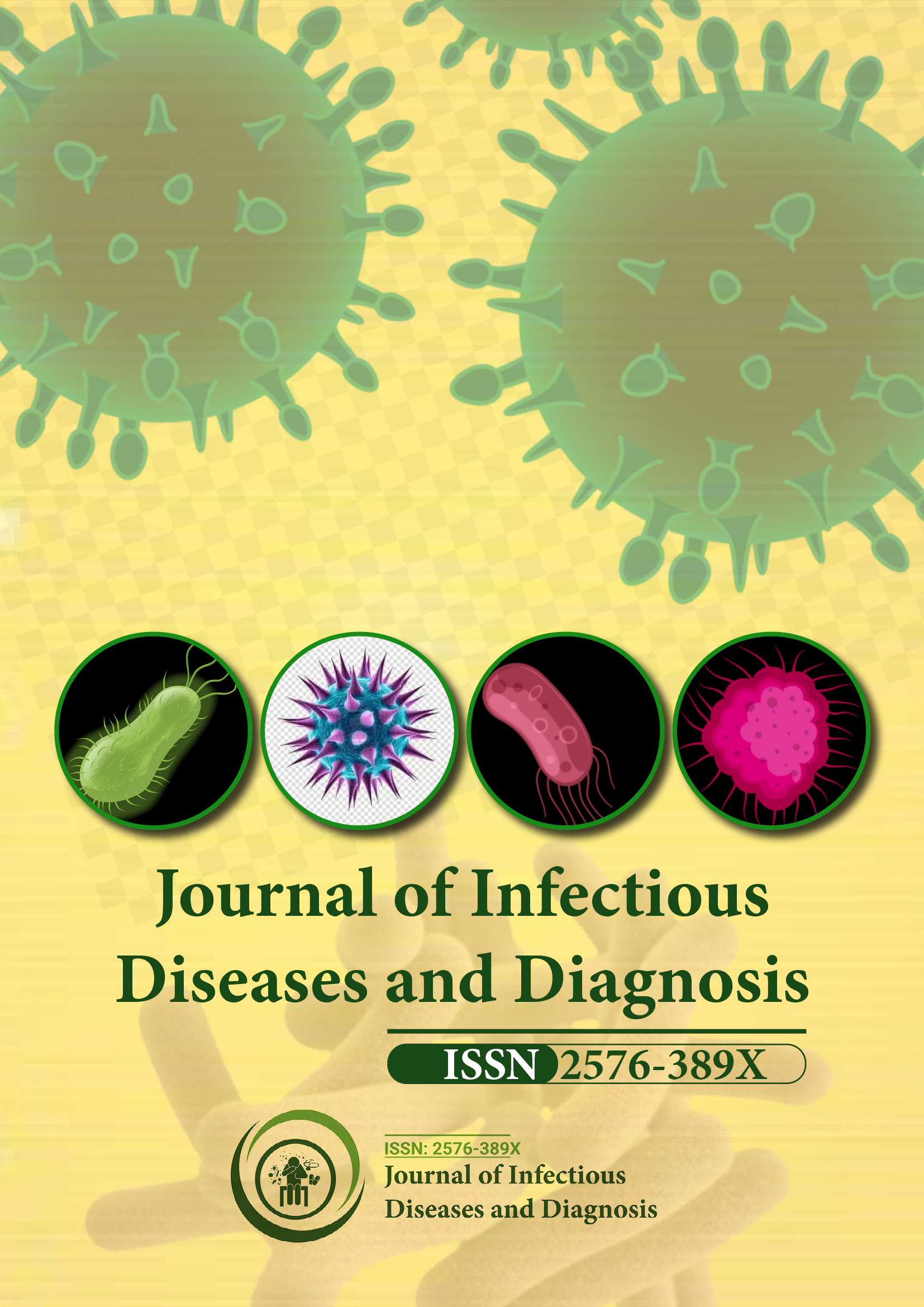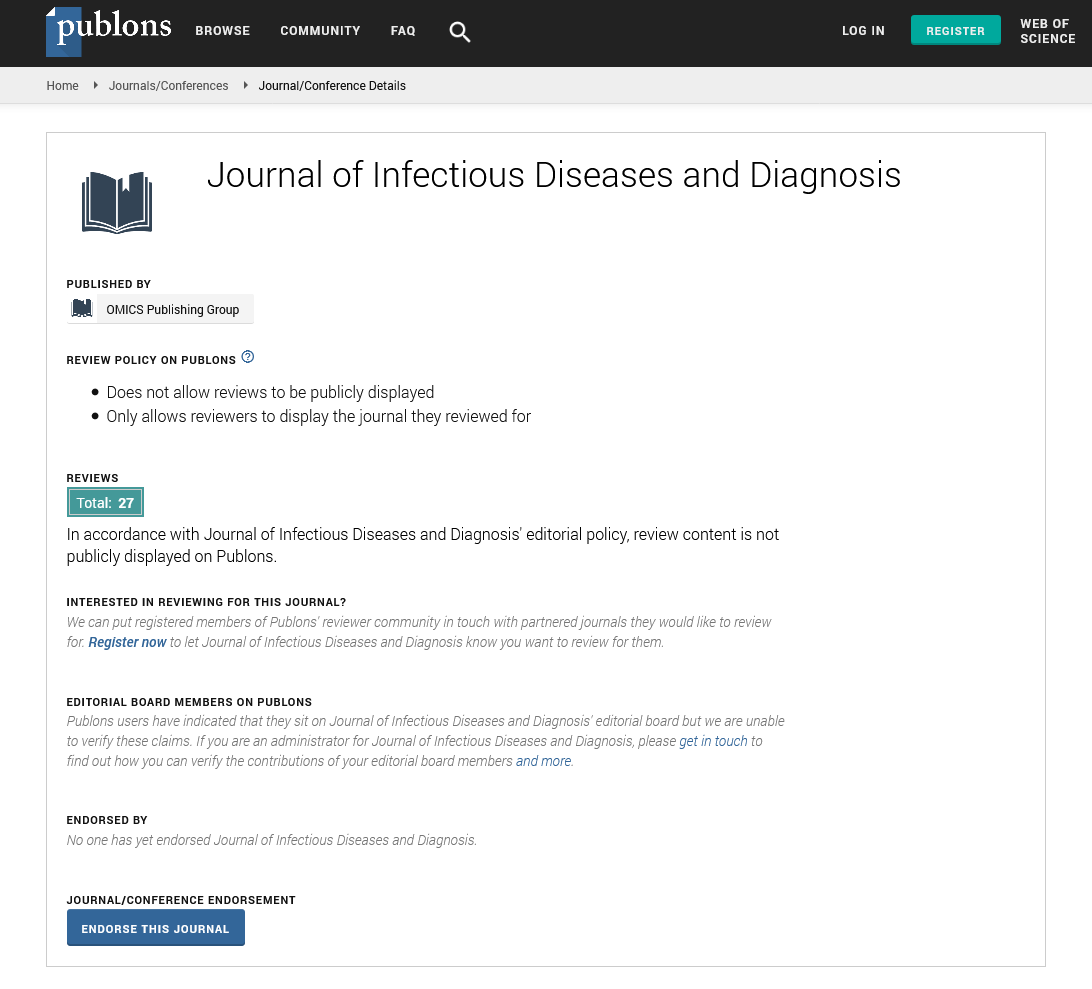Indexed In
- RefSeek
- Hamdard University
- EBSCO A-Z
- Publons
- Euro Pub
- Google Scholar
Useful Links
Share This Page
Journal Flyer

Open Access Journals
- Agri and Aquaculture
- Biochemistry
- Bioinformatics & Systems Biology
- Business & Management
- Chemistry
- Clinical Sciences
- Engineering
- Food & Nutrition
- General Science
- Genetics & Molecular Biology
- Immunology & Microbiology
- Medical Sciences
- Neuroscience & Psychology
- Nursing & Health Care
- Pharmaceutical Sciences
Short Communication - (2025) Volume 10, Issue 2
Meningitis: Understanding the Disease, Causes and Prevention Strategies
Paul Wilson*Received: 25-Feb-2025, Manuscript No. JIDD-25-28665; Editor assigned: 27-Feb-2025, Pre QC No. JIDD-25-28665 (PQ); Reviewed: 14-Mar-2025, QC No. JIDD-25-28665; Revised: 21-Mar-2025, Manuscript No. JIDD-25-28665 (R); Published: 28-Mar-2025, DOI: 10.35248/2576-389X.25.10.319
Description
Meningitis is a serious medical condition characterized by the inflammation of the meninges the protective membranes covering the brain and spinal cord. It can be caused by bacterial, viral, fungal, or parasitic infections, with bacterial and viral meningitis being the most common types. Although it affects people of all ages, infants, young children and individuals with weakened immune systems are especially at risk [1].
Causes and types
The underlying cause of meningitis varies depending on the infecting organism. Bacterial meningitis is usually more severe and requires immediate treatment. Common bacteria responsible for this condition include Streptococcus pneumoniae, Neisseria meningitidis and Haemophilus influenzae type b (Hib). These bacteria can enter the bloodstream and travel to the brain and spinal cord, resulting in inflammation.
Viral meningitis is typically less severe than the bacterial form and often resolves on its own. Enteroviruses are the leading cause, but other viruses such as herpes simplex virus, mumps virus and HIV can also lead to meningitis [2-4].
Less frequently, fungal meningitis occurs in people with compromised immune function, such as those with HIV/AIDS or cancer. It is most often caused by the fungus Cryptococcus. Parasitic meningitis is rare and can result from organisms like Naegleria fowleri, commonly found in warm freshwater.
Non-infectious causes also exist and can include certain medications, autoimmune disorders and head injuries.
Diagnosis
Diagnosing meningitis involves a combination of clinical evaluation and laboratory testing. A healthcare provider will assess the patient’s symptoms and medical history before conducting further tests. The most definitive method of diagnosis is a lumbar puncture, also known as a spinal tap, which involves collecting Cerebrospinal Fluid (CSF) from the lower back for analysis [5]. CSF analysis can determine the presence of infection, identify the type of organism involved and guide treatment decisions. Additional tests may include blood cultures, imaging scans and rapid diagnostic tests for specific pathogens [6].
Treatment options
Treatment depends on the cause of the disease. Bacterial meningitis requires immediate hospitalization and administration of intravenous antibiotics. In some cases, corticosteroids may be used to reduce inflammation and prevent complications like hearing loss.
Viral meningitis usually does not require specific treatment beyond supportive care, including rest, hydration and over-thecounter medications to relieve symptoms. However, certain viruses, like herpes simplex, may be treated with antiviral drugs [7].
Fungal and parasitic forms of meningitis need targeted therapies, often involving long courses of antifungal or anti-parasitic medications. Recovery can be prolonged, especially in individuals with underlying health conditions [8].
Prevention and vaccination
Several forms of meningitis can be prevented through vaccination. Immunizations against Neisseria meningitidis (meningococcal vaccine), Streptococcus pneumoniae (pneumococcal vaccine) and Haemophilus influenzae type b (Hib vaccine) have significantly reduced the incidence of meningitis in many parts of the world.
Vaccination schedules vary by country, but children typically receive these vaccines as part of routine immunizations. In some cases, adolescents and adults especially those living in communal settings like college dormitories or military barracks may be advised to get vaccinated as well.
Maintaining good hygiene can also reduce the spread of viruses and bacteria that lead to meningitis. Regular handwashing, avoiding close contact with infected individuals and practicing respiratory etiquette (such as covering the mouth and nose when coughing or sneezing) are all effective measures [9,10].
Global burden and public health efforts
Despite progress in prevention and treatment, meningitis remains a public health challenge, especially in low- and middleincome countries. The so-called "meningitis belt" of sub-Saharan Africa continues to experience frequent outbreaks, particularly of meningococcal meningitis.
Public health agencies and international organizations are working to expand access to vaccines, improve outbreak response and raise awareness. Surveillance systems help detect cases early and coordinate emergency vaccination campaigns when necessary.
Conclusion
Meningitis is a life-threatening disease that requires swift recognition and action. While advancements in medicine and public health have reduced its toll, gaps remain in global prevention and treatment efforts. Early diagnosis, timely medical care and widespread vaccination are the best tools available to reduce its impact. Continued research, public awareness and healthcare access will play an important role in reducing the burden of this disease worldwide.
References
- Hasbun R, Abrahams J, Jekel J, Quagliarello VJ. Computed tomography of the head before lumbar puncture in adults with suspected meningitis. N Engl J Med. 2001;345(24):1727-1733.
[Crossref] [Google Scholar] [PubMed]
- McGill F, Heyderman RS, Panagiotou S, Tunkel AR, Solomon T. Acute bacterial meningitis in adults. Lancet. 2016;388(10063):3036-3047.
- Tunkel AR, Hartman BJ, Kaplan SL, Kaufman BA, Roos KL, Scheld WM, et al. Practice guidelines for the management of bacterial meningitis. Clin Infect Dis. 2004;39(9):1267-1284.
[Crossref] [Google Scholar] [PubMed]
- Posadas E, Fisher J. Pediatric bacterial meningitis: an update on early identification and management. Pediatr Emerg Med Pract. 2018;15(11):1-20.
[Crossref] [Google Scholar] [PubMed]
- Ashwal S, Tomasi L, Schneider S, Perkin R, Thompson J. Bacterial meningitis in children: Pathophysiology and treatment. Neurology. 1992;42(4):739-748.
[Crossref] [Google Scholar] [PubMed]
- Van de Beek D, Brouwer MC, Thwaites GE, Tunkel AR. Advances in treatment of bacterial meningitis. Lancet. 2012;380(9854):1693-1702.
[Crossref] [Google Scholar] [PubMed]
- Thigpen MC, Whitney CG, Messonnier NE, Zell ER, Lynfield R, Hadler JL, et al. Bacterial meningitis in the United States, 1998-2007. N Engl J Med. 2011;364(21):2016-2025.
[Crossref] [Google Scholar] [PubMed]
- Sáez-Llorens X, McCracken GH. Bacterial meningitis in children. Lancet. 2003;361(9375):2139-2148.
- Granerod J, Crowcroft NS. The epidemiology of acute encephalitis. Neuropsychol Rehabil. 2007;17(4-5):406-428.
[Crossref] [Google Scholar] [PubMed]
- Gundamraj V, Hasbun R. Viral meningitis and encephalitis: An update. Curr Opin Infect Dis. 2023;36(3):177-185.
[Crossref] [Google Scholar] [PubMed]
Citation: Wilson P (2025). Meningitis: Understanding the Disease, Causes and Prevention Strategies. J Infect Dis Diagn. 10:319.
Copyright: © 2025 Wilson P. This is an open-access article distributed under the terms of the Creative Commons Attribution License, which permits unrestricted use, distribution and reproduction in any medium, provided the original author and source are credited.

